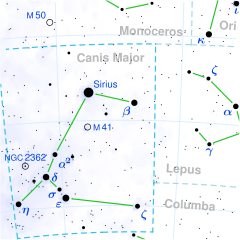Zeta Canis Majoris
| Observation data J2000.0
| ||
|---|---|---|
| Constellation | Canis Major | |
| Right ascension | 06h 20m 18.79204s[1] | |
| Declination | –30° 03′ 48.1202″[1] | |
| Apparent magnitude (V) | +3.025[2] | |
| Characteristics | ||
| Spectral type | B2.5 V[3] | |
| U−B color index | –0.71[2] | |
| B−V color index | –0.195[2] | |
| Variable type | Suspected β Cep[4] | |
| Absolute magnitude (MV) | −2.21[6] | |
Semi-amplitude (K1)(primary) | 13.5 km/s | |
| Details | ||
Myr | ||
| Database references | ||
| SIMBAD | data | |
Zeta Canis Majoris, or ζ Canis Majoris, also named Furud
Name
ζ Canis Majoris, Latinized from Zeta Canis Majoris, is the star's Bayer designation assigned by the German astronomer Johann Bayer in 1603.
The traditional name Furud or Phurud derives from the
In 2016, the International Astronomical Union organized a Working Group on Star Names (WGSN)[17] to catalog and standardize proper names for stars. The WGSN's first bulletin of July 2016[18] included a table of the first two batches of names approved by the WGSN; which included Furud for this star.
Properties
The binary nature of this system was first noted by
The primary component is a large star with nearly four
Zeta Canis Majoris is located close to the
References
- ^ S2CID 18759600
- ^ Bibcode:1972MNSSA..31...69C
- ^ Bibcode:1982mcts.book.....H
- ^ hdl:2066/36162
- ^ Bibcode:1967IAUS...30...57E
- S2CID 119257644.
- S2CID 119387088.
- ^ doi:10.1086/431207
- ^ S2CID 118629873
- ^
- ^ S2CID 111387483
- doi:10.1086/340590
- ^ "zet CMa -- Cepheid variable Star", SIMBAD Astronomical Object Database, Centre de Données astronomiques de Strasbourg, retrieved 2012-02-15
- ^ "IAU Catalog of Star Names". Retrieved 28 July 2016.
- ISBN 978-1-931559-44-7.
- ISBN 0-486-21079-0, retrieved 2010-12-12
- ^ "IAU Working Group on Star Names (WGSN)". Retrieved 22 May 2016.
- ^ "Bulletin of the IAU Working Group on Star Names, No. 1" (PDF). Retrieved 28 July 2016.
- doi:10.1086/141645.
- doi:10.1086/141699.
- ^ "The Colour of Stars", Australia Telescope, Outreach and Education, Commonwealth Scientific and Industrial Research Organisation, December 21, 2004, archived from the original on 2013-12-03, retrieved 2012-01-16
External links
- Kaler, James B., "FURUD (Zeta Canis Majoris)", Stars, University of Illinois, retrieved 2012-02-16

